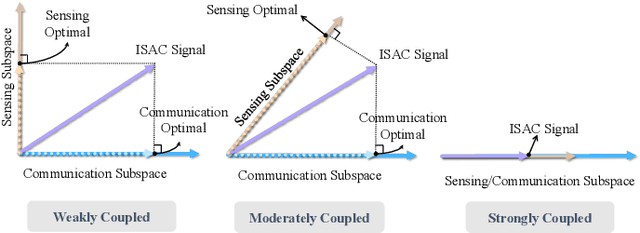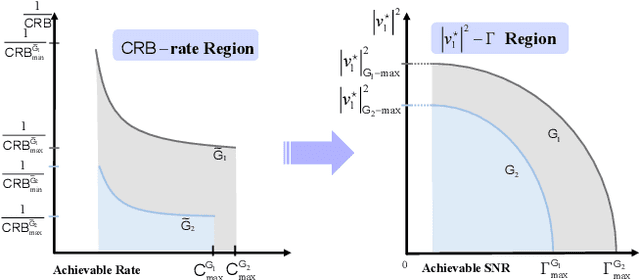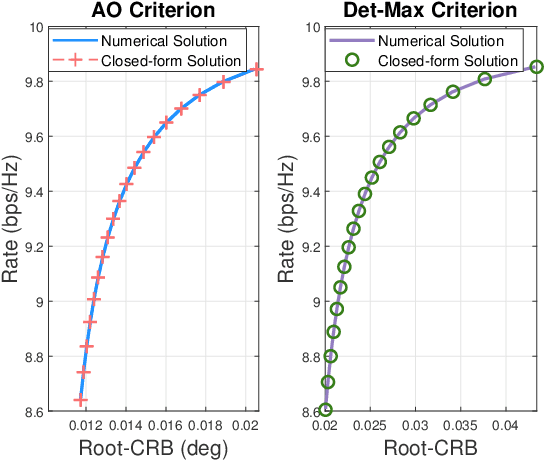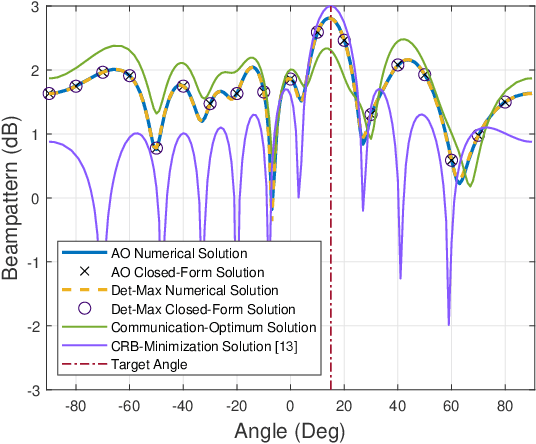Zhen Du
Sensing With Random Communication Signals
Apr 09, 2025



Abstract:Communication-centric Integrated Sensing and Communication (ISAC) has been recognized as a promising methodology to implement wireless sensing functionality over existing network architectures, due to its cost-effectiveness and backward compatibility to legacy cellular systems. However, the inherent randomness of the communication signal may incur huge fluctuations in sensing capabilities, leading to unfavorable detection and estimation performance. To address this issue, we elaborate on random ISAC signal processing methods in this article, aiming at improving the sensing performance without unduly deteriorating the communication functionality. Specifically, we commence by discussing the fundamentals of sensing with random communication signals, including the performance metrics and optimal ranging waveforms. Building on these concepts, we then present a general framework for random ISAC signal transmission, followed by an in-depth exploration of time-domain pulse shaping, frequency-domain constellation shaping, and spatial-domain precoding methods. We provide a comprehensive overview of each of these topics, including models, results, and design guidelines. Finally, we conclude this article by identifying several promising research directions for random ISAC signal transmission.
Frame Structure and Protocol Design for Sensing-Assisted NR-V2X Communications
Dec 27, 2023Abstract:The emergence of the fifth-generation (5G) New Radio (NR) technology has provided unprecedented opportunities for vehicle-to-everything (V2X) networks, enabling enhanced quality of services. However, high-mobility V2X networks require frequent handovers and acquiring accurate channel state information (CSI) necessitates the utilization of pilot signals, leading to increased overhead and reduced communication throughput. To address this challenge, integrated sensing and communications (ISAC) techniques have been employed at the base station (gNB) within vehicle-to-infrastructure (V2I) networks, aiming to minimize overhead and improve spectral efficiency. In this study, we propose novel frame structures that incorporate ISAC signals for three crucial stages in the NR-V2X system: initial access, connected mode, and beam failure and recovery. These new frame structures employ 75% fewer pilots and reduce reference signals by 43.24%, capitalizing on the sensing capability of ISAC signals. Through extensive link-level simulations, we demonstrate that our proposed approach enables faster beam establishment during initial access, higher throughput and more precise beam tracking in connected mode with reduced overhead, and expedited detection and recovery from beam failures. Furthermore, the numerical results obtained from our simulations showcase enhanced spectrum efficiency, improved communication performance and minimal overhead, validating the effectiveness of the proposed ISAC-based techniques in NR V2I networks.
Reshaping the ISAC Tradeoff Under OFDM Signaling: A Probabilistic Constellation Shaping Approach
Dec 26, 2023Abstract:Integrated sensing and communications is regarded as a key enabling technology in the sixth generation networks, where a unified waveform, such as orthogonal frequency division multiplexing (OFDM) signal, is adopted to facilitate both sensing and communications (S&C). However, the random communication data embedded in the OFDM signal results in severe variability in the sidelobes of its ambiguity function (AF), which leads to missed detection of weak targets and false detection of ghost targets, thereby impairing the sensing performance. Therefore, balancing between preserving communication capability (i.e., the randomness) while improving sensing performance remains a challenging task. To cope with this issue, we characterize the random AF of OFDM communication signals, and demonstrate that the AF variance is determined by the fourth-moment of the constellation amplitudes. Subsequently, we propose an optimal probabilistic constellation shaping (PCS) approach by maximizing the achievable information rate (AIR) under the fourth-moment, power and probability constraints, where the optimal input distribution may be numerically specified through a modified Blahut-Arimoto algorithm. To reduce the computational overheads, we further propose a heuristic PCS approach by actively controlling the value of the fourth-moment, without involving the communication metric in the optimization model, despite that the AIR is passively scaled with the variation of the input distribution. Numerical results show that both approaches strike a scalable performance tradeoff between S&C, where the superiority of the PCS-enabled constellations over conventional uniform constellations is also verified. Notably, the heuristic approach achieves very close performance to the optimal counterpart, at a much lower computational complexity.
Interference-Resilient OFDM Waveform Design with Subcarrier Interval Constraint for ISAC Systems
Dec 26, 2023Abstract:Conventional orthogonal frequency division multiplexing (OFDM) waveform design in integrated sensing and communications (ISAC) systems usually selects the channels with high-frequency responses to transmit communication data, which does not fully consider the possible interference in the environment. To mitigate these adverse effects, we propose an optimization model by weighting between peak sidelobe level and communication data rate, with power and communication subcarrier interval constraints. To tackle the resultant nonconvex problem, an iterative adaptive cyclic minimization (ACM) algorithm is developed, where an adaptive iterative factor is introduced to improve convergence. Subsequently, the least squares algorithm is used to reduce the coefficient of variation of envelopes by further optimizing the phase of the OFDM waveform. Finally, the numerical simulations are provided to demonstrate the interference-resilient ability of the proposed OFDM strategy and the robustness of the ACM algorithm.
Probabilistic Constellation Shaping for OFDM-Based ISAC Signaling
Oct 27, 2023



Abstract:Integrated Sensing and Communications (ISAC) has garnered significant attention as a promising technology for the upcoming sixth-generation wireless communication systems (6G). In pursuit of this goal, a common strategy is that a unified waveform, such as Orthogonal Frequency Division Multiplexing (OFDM), should serve dual-functional roles by enabling simultaneous sensing and communications (S&C) operations. However, the sensing performance of an OFDM communication signal is substantially affected by the randomness of the data symbols mapped from bit streams. Therefore, achieving a balance between preserving communication capability (i.e., the randomness) while improving sensing performance remains a challenging task. To cope with this issue, in this paper we analyze the ambiguity function of the OFDM communication signal modulated by random data. Subsequently, a probabilistic constellation shaping (PCS) method is proposed to devise the probability distributions of constellation points, which is able to strike a scalable S&C tradeoff of the random transmitted signal. Finally, the superiority of the proposed PCS method over conventional uniformly distributed constellations is validated through numerical simulations.
Towards ISAC-Empowered Vehicular Networks: Framework, Advances, and Opportunities
May 01, 2023Abstract:Connected and autonomous vehicle (CAV) networks face several challenges, such as low throughput, high latency, and poor localization accuracy. These challenges severely impede the implementation of CAV networks for immersive metaverse applications and driving safety in future 6G wireless networks. To alleviate these issues, integrated sensing and communications (ISAC) is envisioned as a game-changing technology for future CAV networks. This article presents a comprehensive overview on the application of ISAC techniques in vehicle-to-infrastructure (V2I) networks. We cover the general system framework, representative advances, and a detailed case study on using the 5G New Radio (NR) waveform for sensing-assisted communications in V2I networks. Finally, we highlight open problems and opportunities in the field.
Performance of OTFS-NOMA Scheme for Coordinated Direct and Relay Transmission Networks in High-Mobility Scenarios
Mar 05, 2023


Abstract:In this letter, an orthogonal time frequency space (OTFS) based non-orthogonal multiple access (NOMA) scheme is investigated for the coordinated direct and relay transmission system, where a source directly communicates with a near user with high mobile speed, and it needs the relaying assistance to serve the far user also having high mobility. Due to the coexistence of signal superposition coding and multi-domain transformation, the performance of OTFS-based NOMA is usually challenging to be measured from a theoretical perspective. To accurately evaluate the system performance of the proposed scheme, we derive the closed-form expressions for the outage probability and the outage sum rate by using the Inversion formula and characteristic function. Numerical results verify the performance superiority and the effectiveness of the proposed scheme.
ISAC-Enabled V2I Networks Based on 5G NR: How Many Overheads Can Be Reduced?
Jan 30, 2023



Abstract:The emergence of the fifth-generation (5G) New Radio (NR) brings additional possibilities to vehicle-to-everything (V2X) network with improved quality of services. In order to obtain accurate channel state information (CSI) in high-mobility V2X networks, pilot signals and frequent handover between vehicles and infrastructures are required to establish and maintain the communication link, which increases the overheads and reduces the communication throughput. To address this issue, integrated sensing and communications (ISAC) was employed at the base station (BS) in the vehicle-to-infrastructure (V2I) network to reduce a certain amount of overheads, thus improve the spectral efficiency. Nevertheless, the exact amount of overheads reduction remains unclear, particularly for practical NR based V2X networks. In this paper, we study a link-level NR based V2I system employing ISAC signaling to facilitate the communication beam management, where the Extended Kalman filtering (EKF) algorithm is performed to realize the functions of tracking and predicting the motion of the vehicle. We provide detailed analysis on the overheads reduction with the aid of ISAC, and show that up to 43.24% overheads can be reduced under assigned NR frame structure. In addition, numerical results are provided to validate the improved performance on the beam tracking and communication throughput.
On the Performance Gain of Integrated Sensing and Communications: A Subspace Correlation Perspective
Nov 02, 2022



Abstract:In this paper, we shed light on the performance gain of integrated sensing and communications (ISAC) from the perspective of channel correlations between radar sensing and communication (S&C), namely ISAC subspace correlation. To begin with, we consider a multi-input multi-output (MIMO) ISAC system and reveal that the optimal ISAC signal is in the subspace spanned by the transmitted steering vectors of the sensing channel and the right singular matrix of the communication channel. By leveraging this result, we study a basic ISAC scenario with a single target and a single-antenna communication user, and derive the optimal waveform covariance matrix for minimizing the estimation error under a given communication rate constraint. To quantify the integration gain of ISAC systems, we define the subspace "correlation coefficient" to characterize the coupling effect between S&C channels. Finally, numerical results are provided to validate the effectiveness of the proposed approaches.
Integrated Sensing and Communications for V2I Networks: Dynamic Predictive Beamforming for Extended Vehicle Targets
Nov 26, 2021



Abstract:We investigate sensing-assisted predictive beamforming schemes for vehicle-to-infrastructure (V2I) communication by exploiting the integrated sensing and communication (ISAC) functionalities at the roadside unit (RSU). The RSU deploys a massive multi-input-multi-output (mMIMO) array and operates at millimeter wave (mmWave) frequencies. The pencil-sharp mMIMO beams and fine range resolution achieved at mmWave, implicates that the point target assumption is impractical in such V2I networks, as the volume and shape of the vehicles become essential for beamforming. Simply pointing a beam to the vehicle may result in the communication receiver (CR) never lying in the beam, even when the vehicle's trajectory is accurately tracked. To tackle this problem, we consider the extended vehicle target with two novel beam tracking schemes. For the first scheme, the beamwidth is adjusted in real-time to cover the entire vehicle, followed by an extended Kalman filtering (EKF) algorithm to predict and track the position of CR according to the resolved high-resolution scatterers. An upgraded scheme is further proposed by splitting each transmission block into two stages. The first stage is exploited for ISAC transmission, where a wide beam is adopted for both communication and sensing. Based on the sensed results at the first stage, the second stage is dedicated to communication by adopting a pencil-sharp beam, yielding a significant improvement of the achievable rate. We further reveal the inherent tradeoff between the two stages in terms of their durations, and develop an optimal time allocation strategy that maximizes the average achievable rate. Finally, numerical results are provided to verify the superiorities of proposed schemes over the state-of-the-art methods.
 Add to Chrome
Add to Chrome Add to Firefox
Add to Firefox Add to Edge
Add to Edge